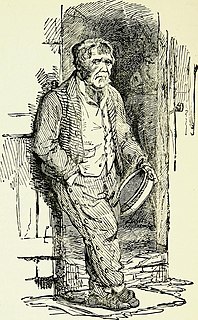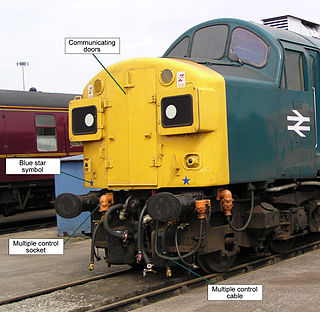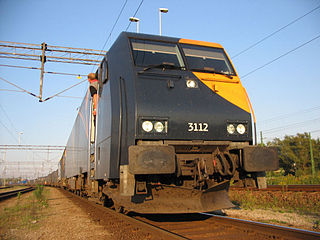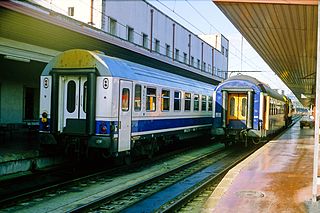 W
WA railway has two major components: the infrastructure and the rolling stock
 W
WAutonomous Decentralized Transport Operation Control System or ATOS is a computerized control system used by the East Japan Railway Company to regulate train traffic on railway lines in metropolitan Tokyo, Japan. It was designed by Hitachi. The first deployment was on the Chūō Main Line in 1997. It is now used on fourteen lines listed below.
 W
WA bank engine, banking engine, helper engine or pusher engine is a railway locomotive that temporarily assists a train that requires additional power or traction to climb a gradient. Helpers/bankers are most commonly found in mountain divisions, where the ruling grade may demand the use of substantially greater motive power than that required for other grades within the division.
 W
WBogie exchange is a system for operating railway wagons on two or more gauges to overcome difference in the track gauge. To perform a bogie exchange, a car is converted from one gauge to another by removing the bogies or trucks, and installing a new bogie with differently spaced wheels. It is generally limited to wagons and carriages, though the bogies on diesel locomotives can be exchanged if enough time is available.
 W
WDieselisation is the process of equipping something with a diesel engine or diesel engines. It can involve replacing an internal combustion engine powered by petrol (gasoline) fuel with an engine powered by diesel fuel, as occurred on a large scale with trucks, buses, farm tractors, and building construction machinery after the Second World War. Alternatively it can involve replacing the entire plant or vehicle with one that is diesel-powered; the term commonly describes the generational replacement between the 1930s and the 1970s of steam locomotives with diesel locomotives, and associated facilities.
 W
WIn railroad terminology, double heading indicates the use of two locomotives at the front of a train, each operated individually by its own crew. The practice of triple-heading involves the use of three locomotives. The practice of multi-heading involves the use of multiple locomotives and so on.
 W
WA hostler or ostler is a groom or stableman, who is employed in a stable to take care of horses, usually at an inn. In the twentieth century the word came to be used in railroad industry for a type of train driver.
 W
WThe Karlsruhe model is a tram-train system which consists of tram/light rail trains and commuter/regional rail trains running on the same set of tracks, generally between or outside of urban areas. It was initially developed and implemented in the city of Karlsruhe, Germany by the local transit authority, Karlsruher Verkehrsverbund (KVV).
 W
WMobile post offices deliver mail and other postal services through specially equipped vehicles, such as trucks and trains.
 W
WOn the UK rail network, multiple working is where two or more traction units are coupled together in such a way that they are all under the control of one driver.
 W
WOne-person operation (OPO), also known as driver-only operation (DOO), one-man operation (OMO), single person train operation (SPTO), or one-person train operation (OPTO), similarly to Driver Controlled Operation, is operation of a train, bus, or tram by the driver alone, without a conductor.
 W
WIn rail terminology, portion working refers to the operational practice of coupling two or more passenger trains together over common sections of their respective routes, but otherwise operating the trains separately. This allows multiple trains to use the same path over parts of the network where limited capacity is available.
 W
WRailRadar GPS is a live tracker allowing users to watch the movements of passenger trains running in India on an interactive map. All passenger trains in India are operated by state-owned Indian Railways. In the first release the location and status of trains shown on the map was typically 15 to 30 minutes delayed from real-time. RailRadar was created when Indian Railways Center for Railway Information System (CRIS) and RailYatri joined hands, and the service was launched on 10 October 2012. RailRadar uses Google Maps as its web mapping software, and is accessible in the form of a website and a mobile app. RailRadar was discontinued by Indian Railways on 6 September 2013, before RailYatri relaunched it in November 2013. However the RailRadar service did not provide the actual running status or the actual location of the train, rather these locations were plotted based on the regular scheduled timetable.
 W
WRailway time was the standardised time arrangement first applied by the Great Western Railway in England in November 1840, the first recorded occasion when different local mean times were synchronised and a single standard time applied. The key goals behind introducing railway time were to overcome the confusion caused by having non-uniform local times in each town and station stop along the expanding railway network and to reduce the incidence of accidents and near misses, which were becoming more frequent as the number of train journeys increased.
 W
WSlippery rail, or low railhead adhesion, is a condition of railways (railroads) where contamination of the railhead causes trains to experience less adhesion (grip). This can lead to wheelslip when the train is taking power, and wheelslide when the train is braking. The most common cause of contamination is fallen moist leaves that lie on and cling to the top surface of the rails of railway tracks. The condition results in significant reduction in friction between train wheels and rails, and in extreme cases can render the track temporarily unusable. In Britain, the situation is colloquially referred to as "leaves on the line".
 W
WRail speed limits in the United States are regulated by the Federal Railroad Administration. Railroads also implement their own limits and enforce speed limits. Speed restrictions are based on a number of factors including curvature, signaling, track condition, the physical condition of a train, and the presence of grade crossings. Like road speed limits in the United States, speed limits for rail tracks and the trains that run on them use miles per hour (mph).
 W
WA switcher, shunter, yard pilot, switch engine, yard goat, or shifter is a small railroad locomotive used for manoeuvring railroad cars inside a rail yard in a process known as switching (US) or shunting (UK). Switchers are not intended for moving trains over long distances but rather for assembling trains in order for another locomotive to take over. They do this in classification yards. Switchers may also make short transfer runs and even be the only motive power on branch lines and switching and terminal railroads. The term can also be used to describe the workers operating these engines or engaged in directing shunting operations.
 W
WIn rail terminology, a through coach is a passenger car (coach) that is re-marshalled during the course of its journey. It begins the journey attached to one train, and arrives at its destination attached to another train.
 W
WA train reporting number in Great Britain identifies a particular train service. It consists of:A single-digit number, indicating the class (type) of train, followed by A letter, indicating the destination area, followed by A two-digit number, identifying the individual train or indicating the route.
 W
WA unit train, also called a block train or a trainload service, is a train in which all cars (wagons) carry the same commodity and are shipped from the same origin to the same destination, without being split up or stored en route. They are distinct from wagonload trains, which comprise differing numbers of cars for various customers.
 W
WThe Zwickau model is an inversion of the Karlsruhe model, with diesel main-line trains extended through city streets on tram track. It is so called because the German city of Zwickau was the first to introduce it.